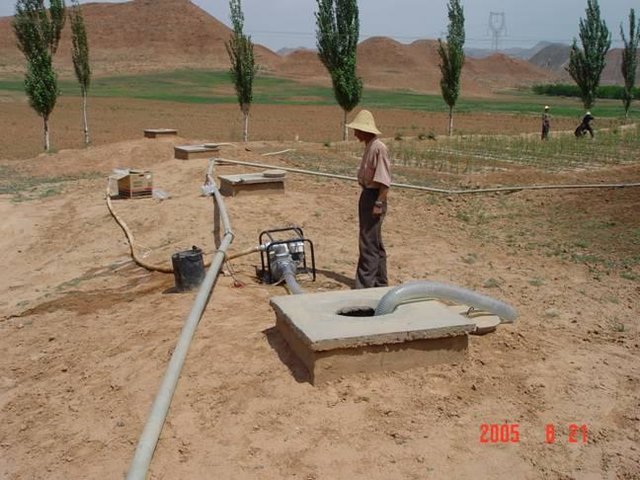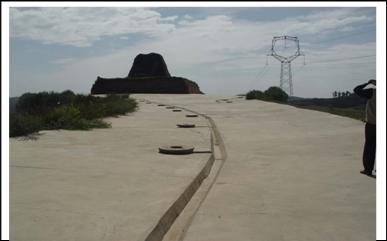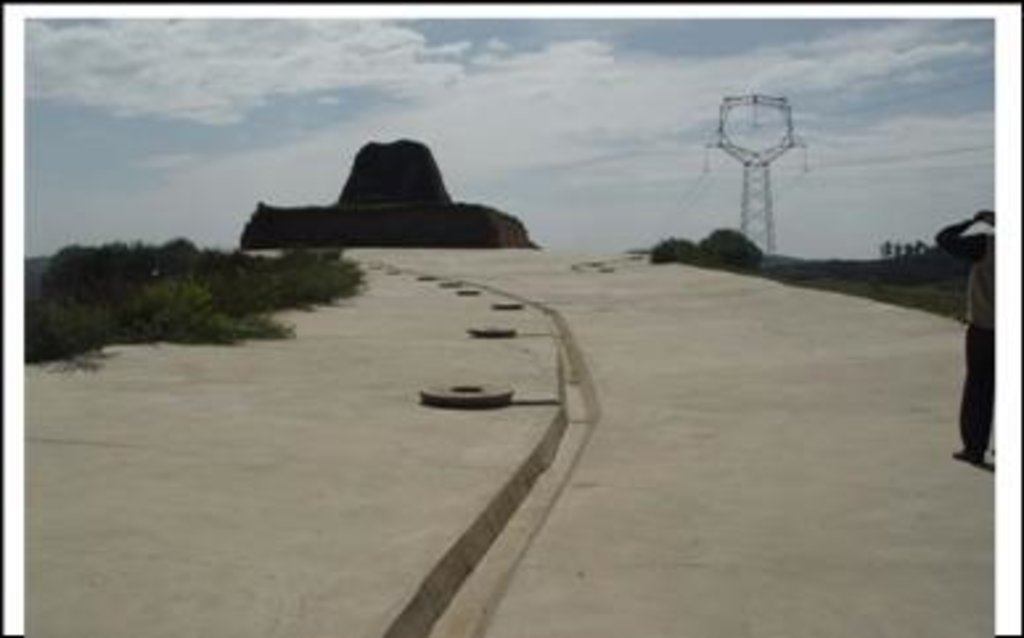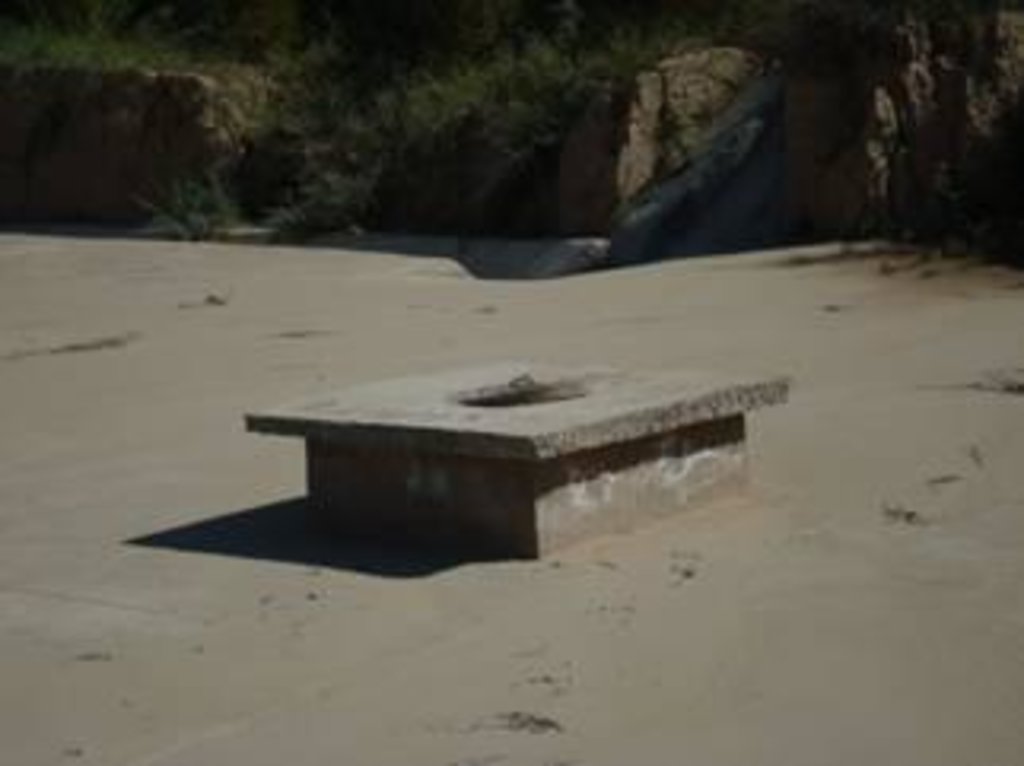Rainwater Cellars [ប្រទេសចិន]
- ការបង្កើត៖
- បច្ចុប្បន្នភាព
- អ្នកចងក្រង៖ Anna Schuler
- អ្នកកែសម្រួល៖ –
- អ្នកត្រួតពិនិត្យច្រើនទៀត៖ Deborah Niggli, Alexandra Gavilano
technologies_1335 - ប្រទេសចិន
ពិនិត្យមើលគ្រប់ផ្នែក
ពង្រីកមើលទាំងអស់ បង្រួមទាំងអស់1. ព័ត៌មានទូទៅ
1.2 ព័ត៌មានលម្អិតពីបុគ្គលសំខាន់ៗ និងស្ថាប័នដែលចូលរួមក្នុងការវាយតម្លៃ និងចងក្រងឯកសារនៃបច្ចេកទេស
ឈ្មោះគម្រោងដែលបានចងក្រងឯកសារ/ វាយតម្លៃលើបច្ចេកទេស (បើទាក់ទង)
Best Practices for Land Degradation Control in Dryland Areas of China (Best Practices China)1.3 លក្ខខណ្ឌទាក់ទងទៅនឹងការប្រើប្រាស់ទិន្នន័យដែលបានចងក្រងតាមរយៈ វ៉ូខេត
អ្នកចងក្រង និង(បុគ្គលសំខាន់ៗ)យល់ព្រមទទួលយកនូវលក្ខខណ្ឌនានាទាក់ទងទៅនឹងការប្រើប្រាស់ទិន្នន័យដែលបានចងក្រងតាមរយៈវ៉ូខេត:
បាទ/ចា៎
1.4 សេចក្តីប្រកាសស្តីពីចីរភាពនៃការពណ៌នាពីបច្ចេកទេស
តើបច្ចេកទេសដែលបានពណ៌នានេះមានបញ្ហាដែលផ្តោតលើការធ្លាក់ចុះគុណភាពដី, បើដូច្នេះវាមិនអាចត្រូវបានប្រកាសថាជាបច្ចេកទេសនៃការគ្រប់គ្រងប្រកបដោយចីរភាពទេ?
ទេ
1.5 ការយោងទៅលើកម្រងបញ្ជីសំណួរ (មួយ ឬច្រើន) នៃវិធីសាស្ត្រផ្សព្វផ្សាយ SLM (ដែលបានចងក្រងដោយទស្សនៈពិភពលោកស្តីពីវិធីសាស្ត្រ និងបច្ចេកទេសងអភិរក្ស WOCAT)

Rainwater Cellars introduced through government support [ប្រទេសចិន]
Government takes the lead and propelled by project, the rainwater collection for irrigation technology scales up by demonstration.
- អ្នកចងក្រង៖ Anna Schuler
2. ការពណ៌នាពីបច្ចេកទេស SLM
2.1 ការពណ៌នាដោយសង្ខេបពីបច្ចេកទេស
និយមន័យបច្ចេកទេស:
The use of courtyard, roof, road surface, slope, etc. as catchments to collect rainwater for underground water storage for future supply of cropland irrigation as well as drinking water for humans and livestock.
2.2 ការពណ៌នាលម្អិតពីបច្ចេកទេស
ការពណ៌នា:
The demonstration site is located in mid Gansu, semi-arid gully area of the Loess Plateau, where either surface or groundwater is in great shortage. The annual precipitation is around 380mm with 60% concentrated in July, August and September in storm form. Due to scarce vegetation and serious soil erosion. The agricultural farming is rainfed, but the timing of precipitation and water demand of crops do not coincide, so that the rainwater utilization is extremely low. Low productivity of land and shortage of water for mankind and animal leads to poverty. Since 1980s the government has organized local people in mid Gansu to explore the utilization of water cellars to achieve coincided precipitation, i.e. collecting rainwater to solve water shortage and develop dryland crop cultivation.
Water cellars are used mainly for the interception of rainwater to supply water for humans and livestock as well as for the irrigation of crops. The cellar is comprised of the cellar body and an ancillary facility, including catchment area, delivery facility (ditch, silt tank, stain interception grate, inlet pipe, cellar opening and irrigation equipment). In general, water cellars are designed to 20-30m3 in capacity. The catchment should be chosen at hillside, road surface, courtyard, roofing, greenhouse roof, etc. For the location selection, considerations should be given to site landform and geological conditions and not proximity to ditch or trench banks, large tree stumps but close to farmland to maximize the possibility of self-flowing irrigation. In consideration of drinking water safety, the cellar should be built far from livestock sheds and toilets to prevent contamination. The silt tank is 2-3m wide, 1m deep and 2-3m away from the cellar opening, and higher than water cellar inlet. The dirt interception grate should be installed 0.5m higher than the base of the silt tank pond and upstream of the inlet. The platform of the water cellar should be 0.3-0.5m high above ground. In Anding District, the concrete cement sphere type water cellar is more often adopted, with the cellar vault/wall of 10cm and base of 20cm thick. At the demonstration site, the inner wall used to be lined with red puddle. Now concrete cement is used for the base and lined with cement and mortar. The water for irrigation does not need special treatment, but drinking water does. Irrigation is done by pumping for watering by ditches flowing to the farmland, hole watering or drip irrigation.
Since mid 1990s, the water cellar has expanded gradually. The 1-2-1 rainwater collection project (each household has 1 catchment, 2 water cellars and 1 patch of courtyard cashcrop forest) has played a significant role in the technology dissemination and poverty alleviation. Since 2000, water cellar function has been further extended toward multifunction for livestock raising, farmland/forest land irrigation and so forth, and greater economic and social benefits are captured by its combination with greenhouse development. Plastic film greenhouse roof was used as the catchment and two water cellars (30 cubic meters capacity for each) were set for each greenhouse. In combination with other technologies of mulched ditch irrigation or drip irrigation, water resource utilization has been tremendously increased. The technology has thereby triggered industrial restructuring as outstanding pilot sites for high benefit agricultural development.
2.3 រូបភាពនៃបច្ចេកទេស
2.5 ប្រទេស/តំបន់/ទីតាំងកន្លែង ដែលបច្ចេកទេសត្រូវបានអនុវត្ត និងបានគ្រប់ដណ្តប់ដោយការវាយតម្លៃនេះ
ប្រទេស:
ប្រទេសចិន
តំបន់/រដ្ឋ/ខេត្ត:
Gansu Province
បញ្ជាក់បន្ថែមពីលក្ខណៈនៃទីតាំង:
Anding District, Dingxi City
មតិយោបល់:
Total area covered by the SLM Technology is 3638.7 km2.
3. ចំណាត់ថ្នាក់នៃបច្ចេកទេស SLM
3.1 គោលបំណងចម្បង (១ ឬច្រើន) នៃបច្ចេកទេសនេះ
- ធ្វើឱ្យប្រសើរឡើងនូវផលិតកម្ម
3.2 ប្រភេទដីប្រើប្រាស់មួយប្រភេទ (ច្រើនប្រភេទ) ដែលបានអនុវត្តបច្ចេកទេស
ដីប្រើប្រាស់ចម្រុះនៅលើដីតែមួយ:
បាទ/ចា៎
បញ្ជាក់ពីប្រភេទដីច្រើនប្រភេទ (ដីដាំដំណាំ/ដីចិញ្ចឹមសត្វ/ដីព្រៃឈើ):
- Agro-pastoralism ( រួមបញ្ចូលទាំងដំណាំ និងចិញ្ចឹមសត្វ)

ដីដាំដំណាំ
សូមបញ្ជាក់:
Longest growing period in days: 140, Longest growing period from month to month: May to October

ដីសម្រាប់ចិញ្ចឹមសត្វ

ផ្លូវទឹក ផ្ទៃទឹក ដីសើម
- ខ្សែទឹក ផ្លូវទឹក
ផលិតផល/សេវាកម្មចម្បង:
Rainwater Cellars
មតិយោបល់:
Major land use problems (compiler’s opinion):
- low precipitation, deficient groundwater, arid and short of water supply;
- rainfall in form of storms to form runoff arousing serious soil and water erosion;
- low and unstable land productivity because of aridness and soil infertility.
3.5 ក្រុម SLM ដែលបច្ចេកទេសស្ថិតនៅក្នុង
- ការគ្រប់គ្រងប្រព័ន្ធស្រោចស្រព (រួមទាំងការផ្គត់ផ្គង់ទឹក ប្រព័ន្ធបង្ហូរ)
- ការបែងចែកទឹក និងប្រព័ន្ធបង្ហូរ
4. បច្ចេកទេសជាក់លាក់ សកម្មភាពអនុវត្ត ធាតុចូល និងថ្លៃដើម
4.4 ថ្លៃដើម និងធាតុចូលដែលត្រូវការសម្រាប់ការបង្កើតបច្ចេកទេស
| បញ្ជាក់ពីធាតុចូល | ឯកតា | បរិមាណ | ថ្លៃដើមក្នុងមួយឯកតា | ថ្លៃធាតុចូលសរុប | % នៃថ្លៃដើមដែលចំណាយដោយអ្នកប្រើប្រាស់ដី | |
|---|---|---|---|---|---|---|
| កម្លាំងពលកម្ម | labour | 1,0 | 140,0 | 140,0 | ||
| សម្ភារៈ | steel bar | 1,0 | 26,7 | 26,7 | ||
| សម្ភារៈសាងសង់ | sand gravel | 1,0 | 33,3 | 33,3 | ||
| សម្ភារៈសាងសង់ | concrete cement | 1,0 | 40,0 | 40,0 | ||
| សម្ភារៈសាងសង់ | bricks | 1,0 | 5,3 | 5,3 | ||
| ផ្សេងៗ | transportation | 1,0 | 26,7 | 26,7 | ||
| ថ្លៃដើមសរុបក្នុងការបង្កើតបច្ចេកទេស | 272,0 | |||||
| ថ្លៃដើមសរុបក្នុងការបង្កើតបច្ចេកទេសគិតជាដុល្លារ | 272,0 | |||||
4.6 កំណត់ថ្លៃដើមសម្រាប់ការថែទាំ/ សកម្មភាពរបស់បច្ចេកទេស (ក្នុងរយៈពេលមួយឆ្នាំ)
| បញ្ជាក់ពីធាតុចូល | ឯកតា | បរិមាណ | ថ្លៃដើមក្នុងមួយឯកតា | ថ្លៃធាតុចូលសរុប | % នៃថ្លៃដើមដែលចំណាយដោយអ្នកប្រើប្រាស់ដី | |
|---|---|---|---|---|---|---|
| កម្លាំងពលកម្ម | labour | 1,0 | 23,3 | 23,3 | 100,0 | |
| ផ្សេងៗ | transportation | 1,0 | 2,67 | 2,67 | 100,0 | |
| ថ្លៃដើមសរុបសម្រាប់ការថែទាំដំណាំតាមបច្ចេកទេស | 25,97 | |||||
| ថ្លៃដើមសរុបសម្រាប់ការថែទាំដំណាំតាមបច្ចេកទេសគិតជាដុល្លារ | 25,97 | |||||
5. លក្ខណៈបរិស្ថានធម្មជាតិ និងមនុស្ស
5.1 អាកាសធាតុ
បរិមាណទឹកភ្លៀងប្រចាំឆ្នាំ
- < 250 មម
- 251-500 មម
- 501-750 មម
- 751-1,000 មម
- 1,001-1,500 មម
- 1,501-2,000 មម
- 2,001-3,000 មម
- 3,001-4,000 មម
- > 4,000 មម
តំបន់កសិអាកាសធាតុ
- មានភ្លៀងតិចតួច
5.2 សណ្ឋានដី
ជម្រាលជាមធ្យម:
- រាបស្មើ (0-2%)
- ជម្រាលតិចតួច (3-5%)
- មធ្យម (6-10%)
- ជម្រាលខ្ពស់បន្តិច (11-15%)
- ទីទួល (16-30%)
- ទីទួលចោត (31-60%)
- ទីទួលចោតខ្លាំង (>60%)
ទម្រង់ដី:
- ខ្ពង់រាប
- កំពូលភ្នំ
- ជម្រាលភ្នំ
- ជម្រាលទួល
- ជម្រាលជើងភ្នំ
- បាតជ្រលងភ្នំ
តំបន់តាមរយៈកម្ពស់ :
- 0-100 ម
- 101-500 ម
- 501-1,000 ម
- 1,001-1,500 ម
- 1,501-2,000 ម
- 2,001-2,500 ម
- 2,501-3,000 ម
- 3,001-4,000 ម
- > 4,000 ម
5.3 ដី
ជម្រៅដីជាមធ្យម:
- រាក់ខ្លាំង (0-20 សម)
- រាក់ (21-50 សម)
- មធ្យម (51-80 សម)
- ជ្រៅ (81-120 សម)
- ជ្រៅខ្លាំង (> 120 សម)
វាយនភាពដី (ស្រទាប់លើ):
- ម៉ត់/ ធ្ងន់ (ឥដ្ឋ)
សារធាតុសរីរាង្គនៅស្រទាប់ដីខាងលើ:
- មធ្យម (1-3%)
5.6 លក្ខណៈនៃអ្នកប្រើប្រាស់ដីដែលអនុវត្តបច្ចេកទេស
ទីផ្សារនៃប្រព័ន្ធផលិតកម្ម:
- ពាក់កណ្តាលពាណិជ្ជកម្ម (ផ្គត់ផ្គង់ខ្លួនឯង/ ពាណិជ្ជកម្ម)
5.8 ភាពជាម្ចាស់ដី កម្មសិទ្ធប្រើប្រាស់ដី និងកម្មសិទ្ធប្រើប្រាស់ទឹក
ភាពជាម្ចាស់ដី:
- រដ្ឋ
- ក្រុម
កម្មសិទ្ធិប្រើប្រាស់ដី:
- ឯកជន
6. ផលប៉ះពាល់ និងការសន្និដ្ឋាន
6.1 ផលប៉ះពាល់ក្នុងបរិវេណអនុវត្តបច្ចេកទេសដែលកើតមាន
ផលប៉ះពាល់លើសេដ្ឋកិច្ចសង្គម
ផលប៉ះពាល់ទៅលើសេដ្ឋកិច្ចសង្គមផ្សេងៗ
Short term economic burden
6.2 ផលប៉ះពាល់ក្រៅបរិវេណអនុវត្តបច្ចេកទេសដែលកើតមាន
Reduce silt inflow of the downstream
Runoff decease of the downstream
6.4 ការវិភាគថ្លៃដើម និងអត្ថប្រយោជន៍
តើផលចំណេញ និងថ្លៃដើមត្រូវបានប្រៀបធៀបគ្នាយ៉ាងដូចម្តេច (ទស្សនៈរបស់អ្នកប្រើប្រាស់ដី)?
រយៈពេលខ្លី:
អវិជ្ជមាន
រយៈពេលវែង:
វិជ្ជមាន
តើផលចំណេញ និងការថែទាំ/ ជួសជុលត្រូវបានប្រៀបធៀបគ្នាយ៉ាងដូចម្តេច (ទស្សនៈរបស់អ្នកប្រើប្រាស់ដី)?
រយៈពេលខ្លី:
វិជ្ជមាន
រយៈពេលវែង:
វិជ្ជមាន
6.7 ភាពខ្លាំង/ គុណសម្បត្តិ/ ឱកាសនៃបច្ចេកទេស
| ភាពខ្លាំង/ គុណសម្បត្តិ/ ឱកាស ទស្សនៈរបស់បុគ្គលសំខាន់ៗ |
|---|
| Intercept and retain runoff and reduce soil and water losses |
| Supplementary irrigation to the cropland for higher production |
6.8 ភាពខ្សោយ/ គុណវិបត្តិ/ ហានិភ័យនៃបច្ចេកទេស និងវិធីសាស្ត្រដោះស្រាយ
| ភាពខ្សោយ/ គុណវិបត្តិ/ ហានិភ័យ ទស្សនៈរបស់អ្នកចងក្រងឬបុគ្គលសំខាន់ៗ | តើបច្ចេកទេសទាំងនោះបានដោះស្រាយបញ្ហាដូចម្តេច? |
|---|---|
| High initial establishment cost | seek more project support |
7. ឯកសារយោង និងវេបសាយ
7.1 វិធីសាស្ត្រ/ ប្រភពនៃព័ត៌មាន
- តាមការចុះទីវាល ការស្រាវជ្រាវនៅទីវាល
- ការសម្ភាសន៍ជាមួយអ្នកប្រើប្រាស់ដី
តើពេលណាដែលទិន្នន័យបានចងក្រង (នៅទីវាល)?
13/09/2007
7.2 ឯកសារយោងដែលបានចេញផ្សាយ
ចំណងជើង អ្នកនិពន្ធ ឆ្នាំ ISBN:
Wang Lin, Water cellar Construction technology for rainwater collection and water-saving irrigation in the mountainous areas, Gansu water conservancy and hydro power technology. 2002 38(4)
ការតភ្ជាប់ និងម៉ូឌុល
ពង្រីកមើលទាំងអស់ បង្រួមទាំងអស់ការតភ្ជាប់

Rainwater Cellars introduced through government support [ប្រទេសចិន]
Government takes the lead and propelled by project, the rainwater collection for irrigation technology scales up by demonstration.
- អ្នកចងក្រង៖ Anna Schuler
ម៉ូឌុល
គ្មានម៉ូឌុល




